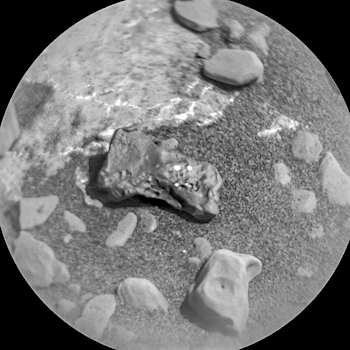 Sol 1985, March 6, 2018, update by MSL scientist Roger Wiens: Last week when the first Vera Rubin Ridge drill-hole attempts turned out to be too shallow at “Lake Orcadie”, discussion in the team turned to the question of, “How hard is that rock? Is there a way to know before starting the drill hole how hard the rock will be, so we can anticipate whether Curiosity’s new drill technique will be successful?” It turns out that the rover team has several indicators of rock hardness: a) retention of natural features such as craters, b) the imprints of wheel marks on the rocks, when we see them, c) scratch marks from the DRT brush, and d) laser pits from ChemCam. This turns out to be a lot of data, especially from ChemCam and MAHLI. However, no one has yet made a quantitative study of rock hardness vs. apparent laser pit depth or brush scratches. The problem is that other factors can affect how… [More at link]
Sol 1985, March 6, 2018, update by MSL scientist Roger Wiens: Last week when the first Vera Rubin Ridge drill-hole attempts turned out to be too shallow at “Lake Orcadie”, discussion in the team turned to the question of, “How hard is that rock? Is there a way to know before starting the drill hole how hard the rock will be, so we can anticipate whether Curiosity’s new drill technique will be successful?” It turns out that the rover team has several indicators of rock hardness: a) retention of natural features such as craters, b) the imprints of wheel marks on the rocks, when we see them, c) scratch marks from the DRT brush, and d) laser pits from ChemCam. This turns out to be a lot of data, especially from ChemCam and MAHLI. However, no one has yet made a quantitative study of rock hardness vs. apparent laser pit depth or brush scratches. The problem is that other factors can affect how… [More at link]
-
Recent Posts
Archives
Links
general
mission instruments
- CRISM: Compact Reconnaissance Imaging Spectrometer for Mars
- CTX: Context Camera
- HiRISE: High Resolution Imaging Science Experiment
- MARSIS: Mars Advanced Radar for Subsurface and Ionosphere Sounding
- SHARAD: Shallow Radar
- THEMIS: Thermal Emission Imaging System
missions
- All Mars missions list
- Curiosity rover
- ExoMars
- Hope (al-Amal) orbiter
- InSight
- Mars Atmosphere and Volatile Evolution Mission (MAVEN)
- Mars Exploration Rovers (MER)
- Mars Express (MEX)
- Mars Odyssey
- Mars Orbiter Mission (MOM) / Mangalyaan
- Mars Reconnaissance Orbiter (MRO)
- Mars Science Laboratory (MSL)
- Perseverance Rover
- Tianwen-1 orbiter/rover
news








